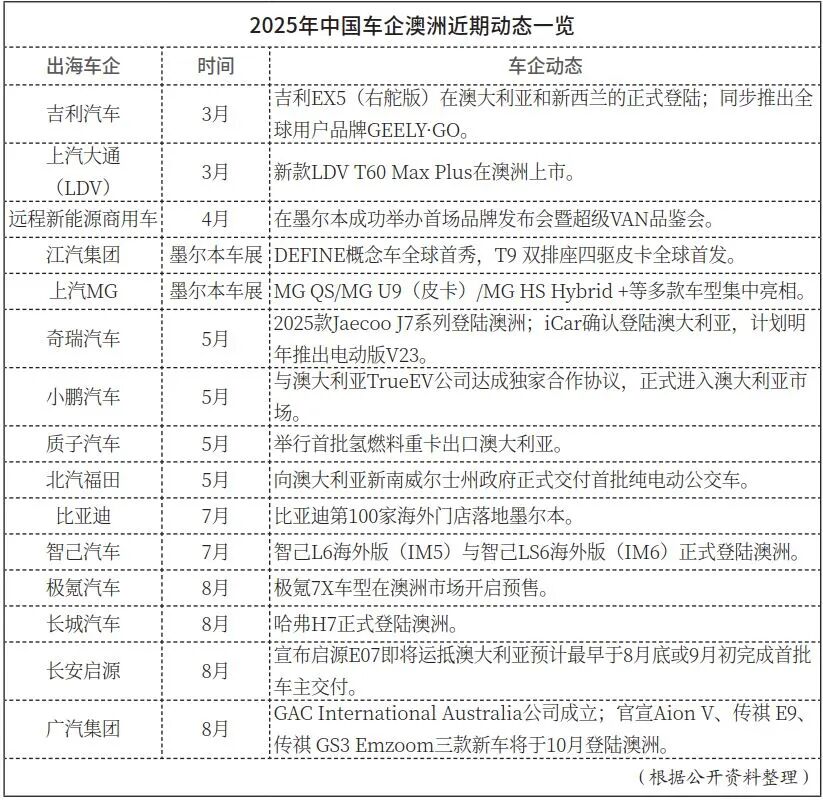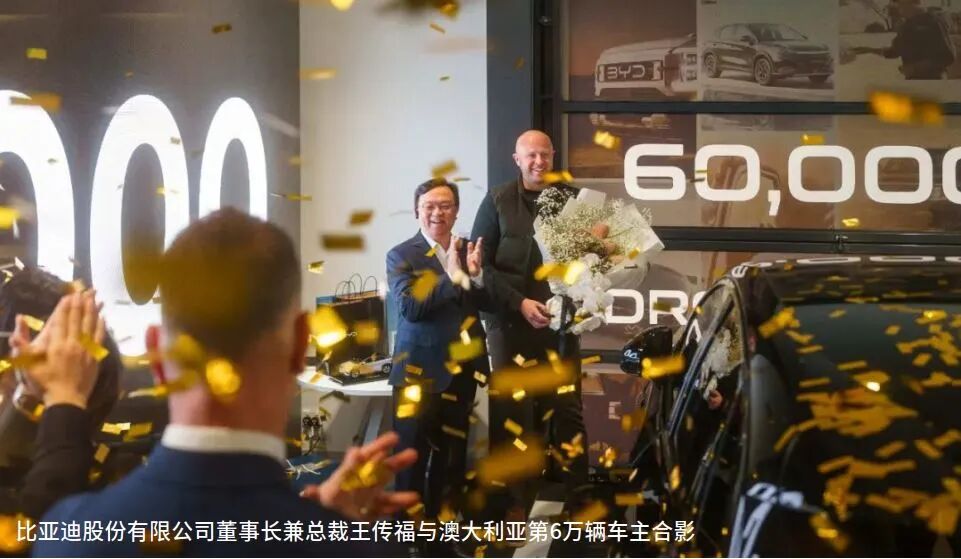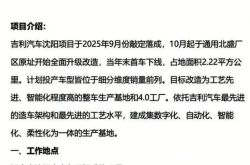Australia: A New Frontier for Chinese Automakers?
![]() 10/13 2025
10/13 2025
![]() 566
566
In the far-flung Southern Hemisphere, Australia—a nation with a population exceeding 27 million and annual car sales consistently topping 1 million vehicles—is quietly emerging as a new hotspot for the global expansion of Chinese automakers.
In recent times, as domestic automotive competition has intensified, venturing abroad has become an imperative for automakers in search of new growth drivers. Australia, with its well-established and stable consumer market, coupled with policy support for new energy vehicles, is now drawing the attention of a growing number of Chinese automotive brands.
According to incomplete statistics compiled by Auto Business Review reporters, at least fifteen Chinese automakers have declared their entry into or have already commenced sales in the Australian market. These companies have not only introduced a wide array of electric vehicle products but are also steadily increasing their investments in sales networks, charging infrastructure, and localized services. Their presence is subtly reshaping the competitive landscape of the local automotive market.
Australia: A New Hotspot for Chinese Automakers' Global Expansion
In fact, the relationship between Chinese automakers and the Australian market has a long history. As early as 2009, some Chinese automakers began exporting to Australia. However, at that time, the vehicles were primarily handled by agents, and due to limitations in product competitiveness and brand recognition, annual sales were merely in the hundreds of units, failing to achieve true mass-market sales. It was only in recent years that Chinese automakers, represented by Chery Automobile, Great Wall Motors, and SAIC Motor, began systematically establishing their presence in the Australian market through official channels, officially initiating their expansion into this overseas market.

It's understood that while the scale of the Australian automotive market may not rival that of Southeast Asia or Europe, it is relatively mature, with annual sales consistently surpassing 1 million vehicles. More significantly, the local government has long placed a strong emphasis on upholding free trade and global fair competition. Not only are its laws and regulations relatively well-developed, but it also abolished import tariffs on Chinese automobiles as early as 2019, providing a relatively equitable competitive environment for Chinese automotive brands.
In terms of policy support, the Australian federal government also maintains a positive stance towards electric vehicles. In its newly launched National EV Strategy, the federal government explicitly set a target of achieving a 30% share of new energy vehicles in total new car sales by 2030. Several state governments have also rolled out substantive incentive policies, such as offering purchase subsidies, registration tax exemptions, and highway toll discounts for electric vehicle consumers in New South Wales, Victoria, and Queensland.
Moreover, in terms of charging network construction, Australia has established a national clean transportation fund to vigorously promote the deployment of charging infrastructure. It plans to construct over 3,000 public charging stations across the country's main roads and major cities by 2027, further propelling Australia's transition to electric mobility. For Chinese automakers, which already possess an edge in the electric vehicle sector, these positive developments undoubtedly bolster their confidence and resolve to explore the Australian market.
Although the current total export volume of Chinese automakers to the Australian market is not particularly high, relevant data reveals that the market share of Chinese brands in Australia has soared from 1.6% in 2019 to nearly 17% in 2024, a growth rate far outpacing that of German and Japanese brands. Meanwhile, the proportion of pure electric vehicle sales in the local new car market has also rapidly increased from less than 1% in 2019 to 10.3% in June this year. Among the best-selling pure electric vehicle rankings, multiple Chinese brands rank prominently.
In particular, BYD has distinguished itself. In the first half of 2025, it entered the top five in Australian automotive brand sales for the first time, thanks to the strong performance of its ATTO 3 (equivalent to the Yuan PLUS in China) and Shark 6 models, competing alongside traditional giants such as Toyota, Mazda, and Ford. Similarly, independent brands like Great Wall Motors, SAIC MG, and Chery have also sustained steady growth in the Australian market.
The stellar performance of Chinese brands is not confined to sales volume but also manifests in the flexibility of their product positioning and pricing strategies. Industry insiders point out that the growth of Chinese automakers in Australia is akin to the rise of Japanese brands in the 1980s. Their success stems not only from affordable prices but also from offering exceptional quality at reasonable prices and low operating costs, a feat that many Chinese automobiles have accomplished. Especially in recent years, Chinese automakers have significantly enhanced product quality, leading to a growing popularity of Chinese cars in the Australian market.
Regarding the series of achievements in Australia, Wang Chuanfu, Chairman and President of BYD Co., Ltd., stated, "We place great importance on the Australian market. It is not only one of the most competitive frontlines in the global automotive industry but also home to a highly mature and discerning consumer base—they not only understand cars but also value innovation, safety, and sustainable development. BYD's success in the Australian market fully proves that our products can meet and even exceed the expectations of mature markets, providing valuable experience and inspiration for global product development and strategic layout." It is reported that BYD recently completed the delivery of its 60,000th vehicle in Australia.

However, as Wang Chuanfu also acknowledged, the Australian market is not without its challenges. According to Australian media reports, a significant portion of local consumers have voiced concerns about the after-sales service of Chinese brands. They believe that Chinese brands are merely "optimistic about the Australian market in the short term" and, in their quest for sales volume, have neglected the construction of after-sales service, maintenance, and spare parts systems. This could result in long waiting times for consumers when their vehicles encounter issues.
From Product Export to Brand Globalization
Addressing consumer concerns and establishing a comprehensive and reliable after-sales service system have become pivotal challenges for Chinese automakers' development in Australia. Currently, some brands have opted to directly collaborate with local Australian dealer groups, leveraging their existing channels to swiftly establish sales and service networks. While this approach can significantly reduce initial investment and time costs, it also brings potential issues. For instance, due to complete reliance on imported vehicles, the reserve and delivery cycles for key spare parts are relatively long, which may hamper maintenance efficiency.
Therefore, in addition to relying on local partnership resources, automakers also need to gradually build an independently controlled logistics system for complete vehicles and spare parts, promoting localized supply chain deployment. For instance, establishing regional spare parts centers, strengthening collaboration with local Australian logistics service providers, and even considering establishing localized assembly capabilities at the right time to enhance response speed and service quality. Only by solidifying and deepening the after-sales support system can they truly earn market trust and achieve sustainable brand development.
On the other hand, Japanese brands such as Toyota, Mazda, and Mitsubishi still dominate the majority of the Australian market share and enjoy strong user loyalty. This implies that Chinese brands must not only address after-sales shortcomings but also continuously invest in brand recognition, user experience, and long-term commitments. By establishing more agile localized service mechanisms and actively integrating into the local automotive market ecosystem, they can gradually accumulate reputation and gain a firm foothold in the fiercely competitive Australian market.
In fact, these strategies align with the current global expansion strategies of mainstream Chinese automakers. Currently, Chinese automotive global expansion has gradually transitioned from the early stage of scale expansion to a high-quality development stage centered on quality enhancement, brand building, and value co-creation.
It is worth mentioning that Yin Tongyue, Chairman of Chery Automobile Co., Ltd., also called for "breaking through internal competition with innovation and promoting high-quality global expansion through collaboration" at the recent China Automotive Forum. He emphasized that in the face of domestic and international market competition, Chinese automakers must break free from low-level competition through technological innovation and industrial chain collaboration to jointly build a healthy and orderly new global expansion ecosystem.
Currently, this concept is gradually becoming a consensus in the Chinese automotive industry's global expansion. Chinese brands are continuously expanding their presence in the Australian market through product diversification, channel localization, cost-effectiveness advantages, and technological integration capabilities. They are also proving with their actions that while the "New World" of the past belonged to colonization and conquest, today's "New World" belongs to innovation and win-win cooperation.
Note: This article was first published in the "Industry Report" section of the September 2025 issue of Auto Business Review magazine. Please stay tuned.
Image: From the Internet
Article: Auto Business Review
Layout: Auto Business Review








